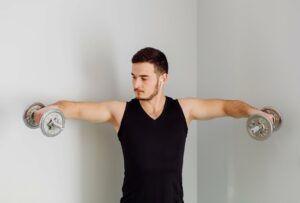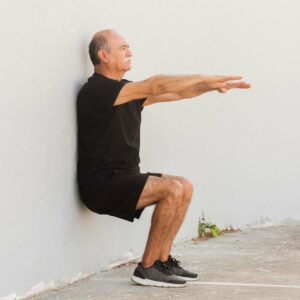Beloeil : 450 527-1239
Laval : 514 500-0264 TAKE AN APPOINTMENT

Rhomboid Muscle Strain: 5 Rehab Exercises
Rhomboid muscle pain is a common issue, often stemming from factors like inadequate posture, excessive use, or abrupt motions. These symptoms are typically due to the rhomboids being overworked, crucial in stabilizing the shoulders and aiding in proper arm movement.
Rehabilitation exercises, particularly under the guidance of professional chiropractors, are effective in alleviating rhomboid muscle pain. They not only help in pain relief but also improve bad body postures. The following exercises are specifically designed to target the rhomboid muscles and improve poor posture.
Exercise 1: Rhomboid Squeezes Using a Resistance Band
A simple yet effective exercise for rhomboid pain involves using a resistance band. Begin by securing the band to a stationary object at chest height. Grasp the ends of the band with both hands and pull your shoulder blades together, squeezing the rhomboid muscles. Maintain the contraction for 5 seconds and repeat it for 10 to 30 times. You can do this a few times per day and you may find instant relief.
Exercise 2: Scapular Retraction Using a Stability Ball
A stability ball introduces an element of instability, engaging more muscles and effectively reducing rhomboid muscle pain. Lie on the ball, face down, with arms straight down. Lift your arms by retracting your shoulder blades, focusing on squeezing the rhomboids. Hold this position for 3 to 5 seconds and repeat it for 10 to 20 times.
Exercise 3: Standing Rows with Dumbbells
Incorporating dumbbells in rehab exercises adds targeted resistance, crucial in physical therapy post-severe injury. Stand with a dumbbell in each hand, arms stretched. Pull the dumbbells towards your chest, keeping elbows close to the body. This exercise should be done for 1-2 minutes.
Exercise 4: Seated Cable Rows
Seated cable rows offer controlled resistance throughout the entire range of motion. Sit at a cable row machine, grasp the handle with both hands and pull towards your chest, retracting your shoulder blades. This exercise, crucial in rehab routines, helps in managing shoulder pain and improving posture, contributing to overall recovery.
Exercise 5: Shoulder Blade Squeezes Against a Wall
This exercise for rhomboid pain requires only a wall, making it accessible and easy to perform. For the starting position, stand with your back against the wall and arms extended at shoulder height. Slowly retract your shoulder blades, pressing them into the wall. Maintain the pressure for 30-60 seconds if possible before letting go, and this may also help with neck pain.
Importance of Proper Form and Technique in Exercises
While performing these rehab exercises, maintaining proper form and technique is paramount. Incorrect form can exacerbate the strain on the rhomboids and lead to further injury. Focus on controlled movements, ensuring that the rhomboid muscles are the primary drivers of the exercises. If needed, seek guidance from a physical therapist or healthcare provider to ensure you perform the activities correctly.
Precautions and Considerations During Rehab
Before diving into a rehab routine for rhomboid pain, it’s essential to consult with a healthcare professional or an experienced chiropractic clinic to determine the severity of your rhomboid muscle strain. Start with lighter resistance and gradually increase as your strength improves, and take a break from exercise when needed. If you experience pain during any exercise, stop immediately and consult your healthcare provider. Additionally, stretching and flexibility exercises can complement your rehab routine, promoting a comprehensive recovery and eliminating sharp pain.
Conclusion
Rhomboid muscle pain can significantly impact daily activities, but with targeted rehab exercises, proper diagnosis, and a treatment plan from a reputable chiropractic clinic, recovery is possible. Remember to prioritize proper form, seek professional guidance if necessary, and approach your rehabilitation with patience and dedication for a long-term solution. Reach out to our experienced team at Kiroclinique for a personalized assessment and effective treatment plan.
FAQ
What causes rhomboid muscle pain?
Rhomboid muscle pain is typically caused by factors such as inadequate posture, excessive use, or sudden movements. These symptoms usually arise from the rhomboids being overworked, which are essential for stabilizing the shoulders and assisting in proper arm movement. When strained, these muscles can lead to significant discomfort or pain in the back and shoulder area.
How do rehabilitation exercises alleviate rhomboid muscle pain?
Rehabilitation exercises alleviate rhomboid muscle pain by strengthening and stabilizing the shoulder area, thus reducing stress on the rhomboids. These exercises, especially when performed under professional guidance, help in correcting poor posture and enhance muscle flexibility, contributing to pain relief and preventing future strain. They target the specific muscles involved, promoting healing and improved function.
What precautions should be taken during rhomboid muscle rehab?
During rhomboid muscle rehab, it’s crucial to start with light exercises and gradually increase intensity to avoid further strain. Consulting a healthcare professional before beginning any routine is essential to assess the injury’s severity. Additionally, if pain is experienced during exercises, it’s important to stop immediately and seek medical advice. Proper technique and form should be maintained throughout to ensure the exercises are effective and safe.


